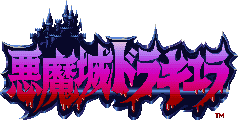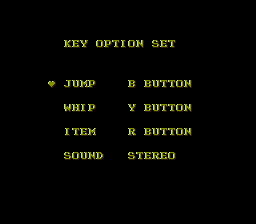 Stage B is accessed naturally from Stage A, but you can also access it via
the password shown above.
Stage B is accessed naturally from Stage A, but you can also access it via
the password shown above.
 The time-limit is set to 500 seconds compared to the finalized version's
999 seconds.
The time-limit is set to 500 seconds compared to the finalized version's
999 seconds.
 This stage, the future castle keep, reuses the extended dungeon theme.
This stage, the future castle keep, reuses the extended dungeon theme.

 There's no crumbing bride in section B-1. Placeholding for it are simple
rows of brown blocks and rows of blocks whose lower halves are replaced
by pairs of 90-degree-rotated copyright symbols.
There's no crumbing bride in section B-1. Placeholding for it are simple
rows of brown blocks and rows of blocks whose lower halves are replaced
by pairs of 90-degree-rotated copyright symbols.

 You run into a major problem when you enter section B-2 (the "death
tower," as I call it). The placeholders for the falling-stair pieces
are stair pieces that have 90-degree-rotated copyright symbols attached
to their bottom portions; they're the type of symbols that possess spike
properties, and as a consequence of such, they instantly kill you if you
make contact with them. So under normal circumstances, it's impossible to
advance past the screen's very first staircase. If you desire to access
the proceeding sections, you're going to have to turn to Action Replay for
help. Specifically, you'll need to input code values of 7E008638 and up
(by increments of one) to reach B-3 and beyond. And you'll necessarily have
to continue inputting codes to access each successive section, since one
doesn't naturally transition into the next; rather, the game freezes the
moment you exit a section. So from this point onward, I'll be using these
codes to piece together the rest of the prototype.
You run into a major problem when you enter section B-2 (the "death
tower," as I call it). The placeholders for the falling-stair pieces
are stair pieces that have 90-degree-rotated copyright symbols attached
to their bottom portions; they're the type of symbols that possess spike
properties, and as a consequence of such, they instantly kill you if you
make contact with them. So under normal circumstances, it's impossible to
advance past the screen's very first staircase. If you desire to access
the proceeding sections, you're going to have to turn to Action Replay for
help. Specifically, you'll need to input code values of 7E008638 and up
(by increments of one) to reach B-3 and beyond. And you'll necessarily have
to continue inputting codes to access each successive section, since one
doesn't naturally transition into the next; rather, the game freezes the
moment you exit a section. So from this point onward, I'll be using these
codes to piece together the rest of the prototype.
 In B-2, by the way, there's no spiked gear to chase you.
In B-2, by the way, there's no spiked gear to chase you.
 Boss music (Boss 1) plays during the Slogra, Gaibon and Death fights.
In the finalized version, this doesn't happen; rather, the normal stage
theme (Room of Close Associates) continues to play during these battles.
Boss music (Boss 1) plays during the Slogra, Gaibon and Death fights.
In the finalized version, this doesn't happen; rather, the normal stage
theme (Room of Close Associates) continues to play during these battles.


 Slogra doesn't drop into his chamber; he simply appears. He lacks his dynamically
changing color-scheme and remains a base brown. When you strike him, he
doesn't zip upward, off the screen; rather, strikes only stall his movement
for about a half a second; in that moment, he merely grimaces before resuming
his forward motion.
Slogra doesn't drop into his chamber; he simply appears. He lacks his dynamically
changing color-scheme and remains a base brown. When you strike him, he
doesn't zip upward, off the screen; rather, strikes only stall his movement
for about a half a second; in that moment, he merely grimaces before resuming
his forward motion.


 The flames that Slogra fires from his spear are purple-colored, and their
explosions have the appearance of electrical bursts. Also, in the battle's
first phase, he exhibits a prototype-exclusive move: He beak-dashes while
holding the spear! And, as is the trend, his death animation can
hurt you.
The flames that Slogra fires from his spear are purple-colored, and their
explosions have the appearance of electrical bursts. Also, in the battle's
first phase, he exhibits a prototype-exclusive move: He beak-dashes while
holding the spear! And, as is the trend, his death animation can
hurt you.
 When you defeat Slogra, a stage-clear orb appears. After you procure it,
your score is tallied as if the stage were completed. It's not. If the prototype
were to adhere to its established formula, you'd be sent to the stage's
next section with your HUD values reset, but that doesn't happen here
because such coding apparently doesn't exist. The game freezes once your
score is finished tallying. Instead you can only access the next section
using an Action Replay code.
When you defeat Slogra, a stage-clear orb appears. After you procure it,
your score is tallied as if the stage were completed. It's not. If the prototype
were to adhere to its established formula, you'd be sent to the stage's
next section with your HUD values reset, but that doesn't happen here
because such coding apparently doesn't exist. The game freezes once your
score is finished tallying. Instead you can only access the next section
using an Action Replay code.
 In the next section, the timer resets to 500.
In the next section, the timer resets to 500.
 Gaibon's chamber doesn't lock into place until he appears, so you have the
opportunity to retreat back to the section's right side if you wish.
Gaibon's chamber doesn't lock into place until he appears, so you have the
opportunity to retreat back to the section's right side if you wish.

 Gaibon's sprite sports a mix of light-purple hues rather than the normal
blue variety.
Gaibon's sprite sports a mix of light-purple hues rather than the normal
blue variety.


 When Gaibon crashes into the ground, rocks, rather than spikes, drop from
the ceiling. Also, before taking back to the air, he appears to shield himself
from further attack.
When Gaibon crashes into the ground, rocks, rather than spikes, drop from
the ceiling. Also, before taking back to the air, he appears to shield himself
from further attack.

 Gaibon spews simple-looking fireballs rather than the rotating type seen
in the finalized version.
Gaibon spews simple-looking fireballs rather than the rotating type seen
in the finalized version.

 Gaibon's second form sports a mix of light-red hues rather than the normal
orange variety.
Gaibon's second form sports a mix of light-red hues rather than the normal
orange variety.


 Phase-2 Gaibon spews a stream of fireballs, as expected, but they're simple-looking
fireballs rather than the rotating type seen in the finalized version. And
this version of Gaibon spews them directly toward Simon rather than
in a strictly-diagonal path.
Phase-2 Gaibon spews a stream of fireballs, as expected, but they're simple-looking
fireballs rather than the rotating type seen in the finalized version. And
this version of Gaibon spews them directly toward Simon rather than
in a strictly-diagonal path.
 Phase-2 Gaibon's flight pattern is different. He tends to swoop down at
low angles and in doing so cover long distances. This makes it very difficult
to avoid making contact with him.
Phase-2 Gaibon's flight pattern is different. He tends to swoop down at
low angles and in doing so cover long distances. This makes it very difficult
to avoid making contact with him.
 Gaibon's death animation can hurt you.
Gaibon's death animation can hurt you.

 When you defeat Gaibon, a stage-clear orb appears. After you procure it,
your score is tallied as if the stage were completed. Again--it's not. Though,
the next part of it can only be accessed via a code. Strangely, the screen
unlocks after Gaibon is defeated, allowing you to travel leftward, over
to the stairs. You can climb them, yes, but there's no point in doing so;
an unseen barrier prevents you from entering the next section via this conventional
method. If you scroll the orb after off the screen, it'll disappear, causing
the game to softlock.
When you defeat Gaibon, a stage-clear orb appears. After you procure it,
your score is tallied as if the stage were completed. Again--it's not. Though,
the next part of it can only be accessed via a code. Strangely, the screen
unlocks after Gaibon is defeated, allowing you to travel leftward, over
to the stairs. You can climb them, yes, but there's no point in doing so;
an unseen barrier prevents you from entering the next section via this conventional
method. If you scroll the orb after off the screen, it'll disappear, causing
the game to softlock.
 In the next section, the timer resets to 500.
In the next section, the timer resets to 500.

 Death lacks his entrance animation. Instead he merely flies in from the
screen's top-right corner; he does so swiftly and wastes no time in dishing
out attacks.
Death lacks his entrance animation. Instead he merely flies in from the
screen's top-right corner; he does so swiftly and wastes no time in dishing
out attacks.
 Death's death animation can hurt you.
Death's death animation can hurt you.
 When you defeat Death, a stage-clear orb appears. After you procure it,
your score is tallied as if the stage were completed. And again--it isn't.
Though, the next part of it can only be accessed via a code.
When you defeat Death, a stage-clear orb appears. After you procure it,
your score is tallied as if the stage were completed. And again--it isn't.
Though, the next part of it can only be accessed via a code.
 In the next section, the timer resets to 500.
In the next section, the timer resets to 500.


 There are no invisble staircases or platforms in the first room of B-4.
There are no invisble staircases or platforms in the first room of B-4.
 Dracula doesn't appear at the end of section B-4. There's only an empty
room that you can leave an any time. The Dracula battle apparently wasn't
yet implemented. So this marks the true end of the prototype.
Dracula doesn't appear at the end of section B-4. There's only an empty
room that you can leave an any time. The Dracula battle apparently wasn't
yet implemented. So this marks the true end of the prototype.






































































































